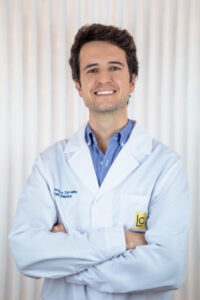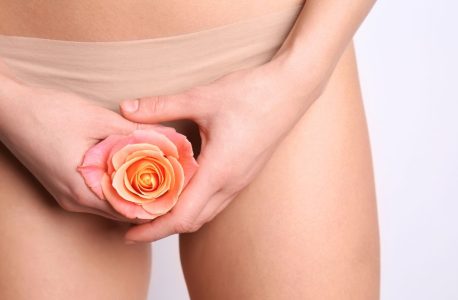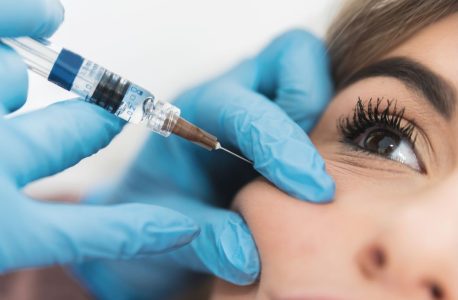Aging is a natural process and with it come certain marks and wrinkles that are not always desirable. One of the areas that attracts the most attention are the famous “crow’s feet”, those fine lines that form around the eyes and accentuate the aged appearance of the skin.
In this article, we’ll talk about the most suitable treatments to combat or prevent crow’s feet.
What are crow’s feet?
Before we look at treatments, it’s essential to understand what crow’s feet actually are.
Crow’s feet wrinkles (also known as crow’s feet) are expression lines that appear mainly when we smile or frown. Over time, our skin loses its elasticity and collagen, which makes these lines more visible and permanent.
What causes crow’s feet?
Crow’s feet are mainly caused by the natural aging of the skin (due to a reduction in collagen and elastin levels) and exposure to the sun’s UV rays over time. In addition, repetitive facial expressions, smoking and stress can also aggravate the visibility of these wrinkles.
Creams for crow’s feet and eye wrinkles
One of the most popular methods for reducing the appearance of eye wrinkles is to apply anti-wrinkle creams specifically formulated for the eye area. These creams usually contain ingredients such as hyaluronic acid and retinol, which help to smooth out wrinkles and improve the elasticity of the skin. In addition, there are serums and gels with peptides and antioxidants that can help stimulate collagen production and minimize the signs of aging.
In general, if you want to improve wrinkles and expression lines around the eyes, you should look for specific anti-ageing eye creams that contain ingredients such as retinoids (retinol, retinaldehyde), peptides, ceramides, hyaluronic acid, vitamins C and E, Niacinamide (vitamin B3), among others.
In addition, if the cream is used during the day, it is essential that it contains sun protection. Exposure to the sun is one of the main causes of premature aging, and the eye area is particularly susceptible. Another way to complement photoprotection is to wear sunglasses whenever you expose yourself. As well as filtering out ultraviolet radiation, they help prevent the eyelids and eyelashes from becoming “frowny”, thus avoiding unwanted wrinkles in this area.
You should bear in mind that anti-wrinkle creams are excellent additions to your skin care routine and offer cumulative benefits with continued use, but they don’t provide results that are as quick and long-lasting as cosmetic treatments. These can prevent wrinkles from forming by paralyzing the periocular muscles as well as stimulating the production of collagen and elastin.
Especially for those looking for more effective solutions to combat crow’s feet, we suggest you read the following section on the most suitable treatments for this purpose.
Aesthetic treatments for crow’s feet
Botulinum toxin: the main treatment for crow’s feet
Botulinum toxin, commonly known as Botox®, is the main and most popular treatment for crow’s feet.
Botulinum toxin is a substance used to reduce expression lines and wrinkles by relaxing the muscles in the treated area.
It is applied through small injections directly into the muscles, causing a temporary paralyzing effect that will result in the wrinkles becoming less visible.
Botulinum toxin blocks the release of acetylcholine, a neurotransmitter responsible for muscle contraction. When a muscle is unable to contract due to the action of the toxin, the skin over that muscle automatically becomes smoother.
The results begin to be visible after 2 or 3 days, peaking in about two weeks. Recovery is almost immediate, but there may be slight swelling or bruising at the site of the injections.
Generally, sessions are needed every 4 to 6 months, as the effects of the substance begin to diminish after this period. However, continued use of botulinum toxin can have “cumulative effects”, making wrinkles less deep over time and spacing out the need for subsequent treatments.
Complementary treatments for crow’s feet
Although botulinum toxin is the most popular treatment, there are other options that can be combined to enhance the results, especially when there is already some degree of sagging skin:
Collagen biostimulators
Collagen biostimulators are injectable products based on hyaluronic acid, calcium or other substances that stimulate collagen production.
When introduced into the skin, they promote firmness and elasticity, combating facial sagging.
The number of sessions varies according to the patient’s needs, but in general, 1 to 3 sessions are recommended. The results are visible after a few weeks and can last up to 2 years, depending on the product used.
Recovery after application of the collagen biostimulator is rapid, but some swelling may occur at the application site.
There are different types of collagen biostimulators, such as Sculptra® and Radiesse®. Your dermatologist will advise you on which product is best for you, depending on your goals.
Hyaluronic acid
There are different types of hyaluronic acid on the market and not all of them are made for use in “facial harmonization”. Some have their own composition for use on wrinkles and expression lines. Others, the so-called skinboosters, only have the function of moisturizing the skin, making it smoother and more lush. In addition to those mentioned above, there is also a category of hyper-concentrated hyaluronic acid that generates, in addition to the hydration already mentioned, a bio-remodelling of collagen in all layers of the skin, as is the case with Profhilo®.
Morpheus 8
Morpheus 8 is a treatment that combines microneedling with radiofrequency. The needles penetrate the skin, while the radiofrequency heats the tissues, stimulating collagen production.
A topical anesthetic is applied to ensure maximum comfort during the procedure.
The results begin to be visible after a few weeks, with continuous improvement over 3 months. More than one session may be necessary, depending on the severity of the wrinkles and sagging.
After the treatment, the skin may be red and sensitive for a few days, but eventually the redness and sensitivity disappear.
CO2 Laser
The Fractional CO2 Laser is a laser treatment that removes superficial layers of skin, promoting regeneration and stimulating collagen production.
The procedure is performed under topical anesthesia.
Depending on the depth of the treatment, a recovery period of 7 to 14 days may be required.
With just one session, the results are visible and long-lasting. Depending on the case, additional sessions may be necessary over time.
Aftercare
After these treatments, it is essential to follow the specialist’s recommendations to ensure the best results and avoid complications. Avoiding sun exposure, using sunscreen daily and moisturizing the skin are essential steps.
How to prevent crow’s feet?
Adopting certain lifestyle habits and making some lifestyle changes can play a key role in preserving the youth of the skin and minimizing the formation of crow’s feet. Some suggestions include regularly using sunscreen with a high SPF, not smoking, eating a balanced diet (which will also have an impact on skin health), staying hydrated, maintaining a daily routine of cleansing and moisturizing the skin in the eye area and, of course, trying to get a good night’s sleep.
In addition, botulinum toxin is also often used to prevent eye wrinkles. As mentioned above, when injected into the skin, botulinum toxin will cause the muscles to relax. As the muscle temporarily stops contracting, the skin in that area stops wrinkling, minimizing the appearance of the marks caused by continuous facial expressions.
Book an appointment
At Living Clinic, we are dedicated to offering you the most advanced and personalized solutions for the health and beauty of your skin. If crow’s feet are a concern for you and you want to explore the most effective treatment options, we invite you to schedule an appointment with us.
A Living Clinic doctor will assess your specific needs, answer all your questions and guide you on the path to rejuvenated, radiant skin.
Responsible for the treatments

Dr. Francisco Martins de Carvalho is a specialist in Plastic, Reconstructive and Aesthetic Surgery. He completed his degree in Medicine at the School of Medicine of the University of Oporto and the Internship in Specific Training in Plastic, Reconstructive and Aesthetic Surgery took place at Hospital de São José (Lisbon) and Hospital de São João (Oporto). Currently, he is also a plastic surgeon at the Hospital de São João – Oporto, and a Invited Lecturer at the School of Medicine of the University of Oporto.
In the field of cosmetic surgery, he has a special interest in facial cosmetic surgery, breast cosmetic surgery, body contouring surgery and vaginal cosmetic surgery.

Dr. Paola Halfeld is a specialist in Dermatology from the Brazilian Medical Association and holds a Master in Public Health from the University of Porto. She completed her degree in Medicine at Estácio de Sá University in Rio de Janeiro. Subsequently, she completed her integrated master’s degree in medicine at the University of Algarve, registering with the Portuguese Medical Society in 2020.
She is a member of the Brazilian Society of Dermatology and a member of the European Academy of Dermatology and Venereology.
During her training, she completed internships at leading institutions such as the Oswaldo Cruz Foundation (Fiocruz) and the National Cancer Institute (INCA). She was a fellow in aesthetic dermatology and trichology (an area of dermatology that studies and treats hair disorders).
Dr. Halfeld is a regular participant in medical conferences and events, contributing to scientific communications as main author and co-author, in addition to numerous courses and training courses in many areas of dermatology. She recently presented her master’s study at the World Congress of Dermatology in Singapore.
Dr. Halfeld has a special interest in the treatment of diseases affecting the scalp and hair and in cosmetic dermatology. It is her practice to perform a complete physical examination for skin cancer screening in all her patients.
Schedule an Appointment
- Are you looking for more information about a specific treatment?
- Would you like to learn more about Living Clinic?
- Would you like to receive the opinion of our specialists?
- Are you interested in scheduling a consultation?






